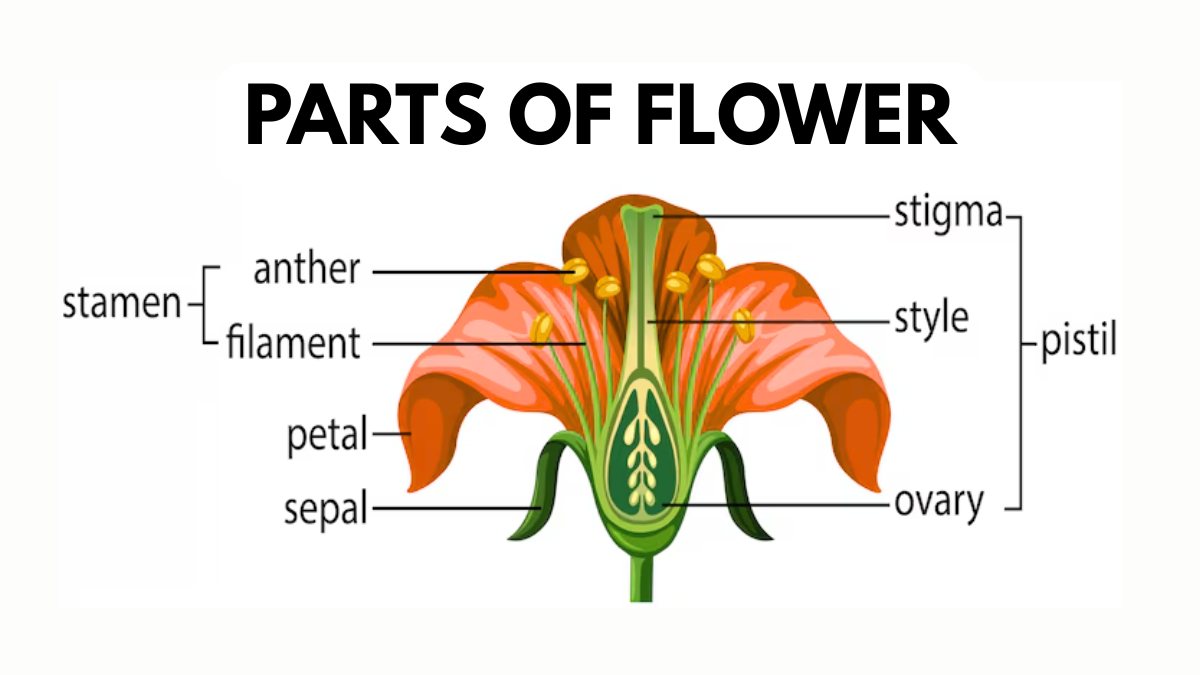Flower Parts: Flowers are one of the most beautiful creations of nature. They are not just pretty to look at, but also play a significant role in the process of reproduction in plants. Every flower, no matter how simple or complex it seems, is made up of different parts that work together to help the plant produce seeds and fruits. From the colorful petals that attract insects to the hidden parts that make pollination possible, each part has a specific job to do.
Understanding the parts of a flower helps us see how plants grow, reproduce, and continue their life cycle. Whether it is a rose, sunflower, or lily, the basic structure of a flower remains the same.
So, let’s explore the main parts of a flower and understand their functions.
Main Parts of a Flower
A flower mainly has four important parts - sepals, petals, stamens, and pistils (or carpels). These parts are usually arranged in whorls or circles on the flower. Each of these parts has a special function that helps the plant in reproduction.

1. Sepals (Calyx)
Sepals are the tiny, green, leaf-like structures that form the outermost layer of a flower, collectively known as the calyx. Their most important role is to act as a protective shield for the delicate flower parts inside, especially when the flower is still a tight, immature bud. Once the flower finally opens up, the sepals typically fold back and remain at the very base of the bloom, continuing to offer a bit of support to the petals and the rest of the flower structure. In some cases, like in lilies or irises, the sepals look just like the petals, and they are then called tepals.
2. Petals (Corolla)
Petals are the brightly colored and often sweet-smelling parts of the flower, and they are what you usually notice first. Their main job is to act like a colorful advertisement to attract helpful insects and animals, such as bees, butterflies, and birds. The vivid colors and pleasant fragrance are signals that guide these visitors right to the flower's center, where they help with pollination by moving pollen around. The entire set of petals is called the corolla. Because every flower attracts a specific type of pollinator, petals come in a huge variety of shapes, sizes, and colors, from the tiny petals on a daisy to the large, showy ones on a rose.
3. Stamens (Androecium)
The stamens are the flower's male reproductive parts, and the whole set is called the androecium. Each stamen is made up of two key pieces: the filament and the anther. The filament is just a thin stalk that acts like a support, holding up the anther. The anther is the crucial bit, it's the small sac where pollen is created and kept. This pollen holds the male cells needed to make new seeds. When a bee or butterfly lands on the flower, it accidentally brushes against the anther, picking up the pollen. When that pollinator flies to the next flower, it carries the pollen with it, completing the first step of reproduction.
4. Pistil or Carpel (Gynoecium)
The pistil (or carpel) is the female reproductive part of the flower, usually found right in the center, and the entire structure is called the gynoecium. It's shaped like a tube and is made of three key sections: the stigma, the style, and the ovary. The stigma is the sticky top where it catches pollen brought by pollinators. That pollen then travels down the style, which is the thin tube connecting the stigma to the base. The ovary is the swollen bottom part that safely holds the ovules (which are like eggs). Once the pollen reaches an ovule in the ovary, fertilization occurs, and that fertilized ovule is what eventually grows into a seed.
Check out: What is the Scientific Name of the Banyan Tree?
Conclusion
A flower may look simple, but it is actually a well-designed system that helps plants reproduce and continue their species. Every part, from the tiny sepal to the colourful petal and the hidden ovary, has an important role.
Comments
All Comments (0)
Join the conversation